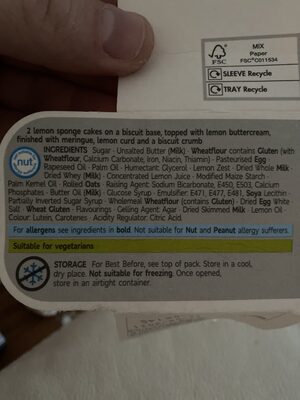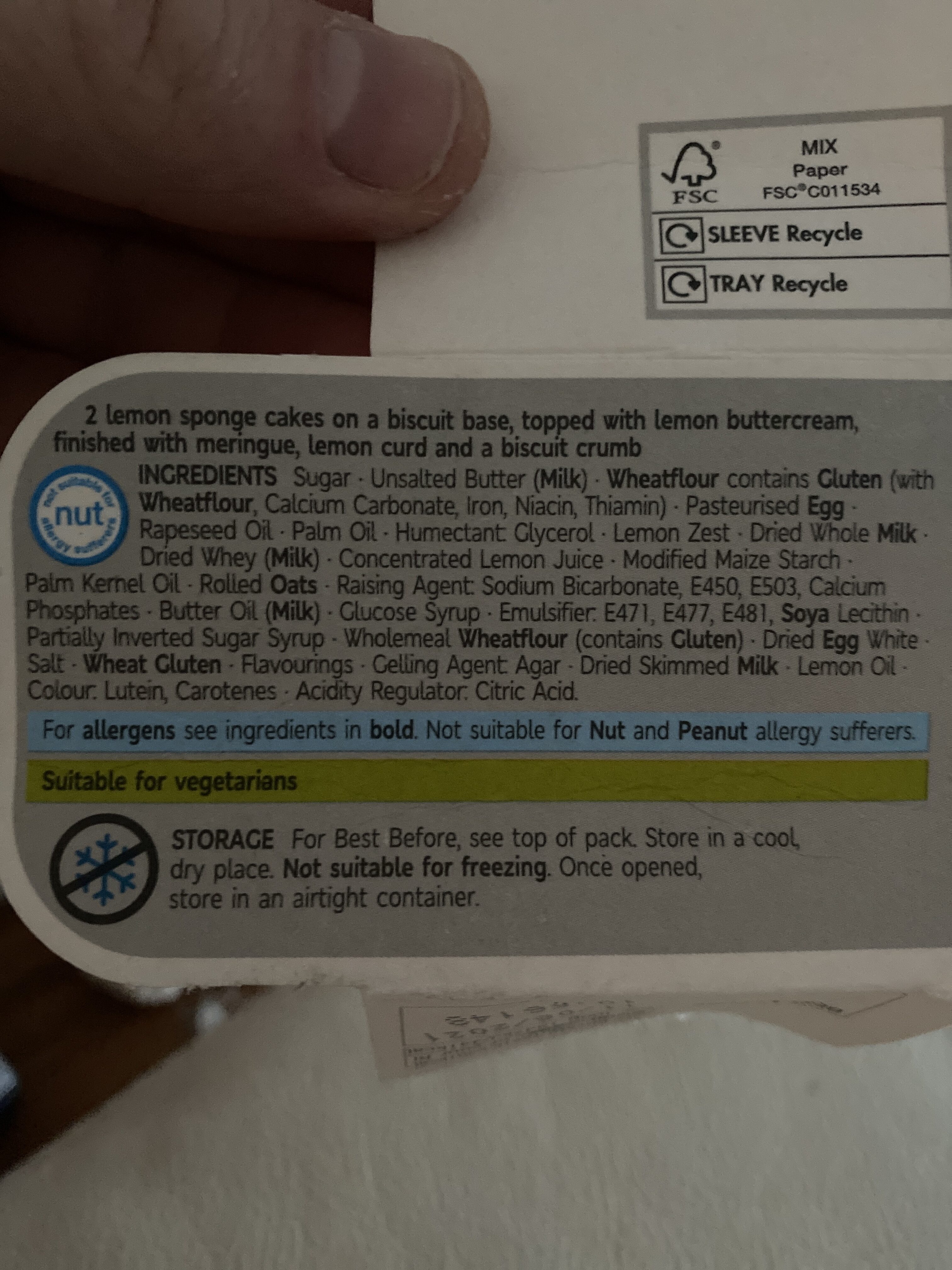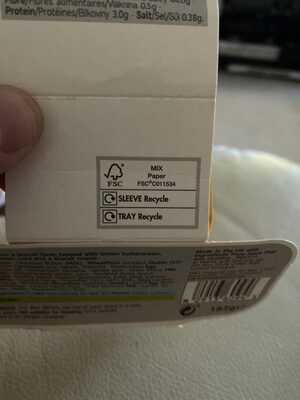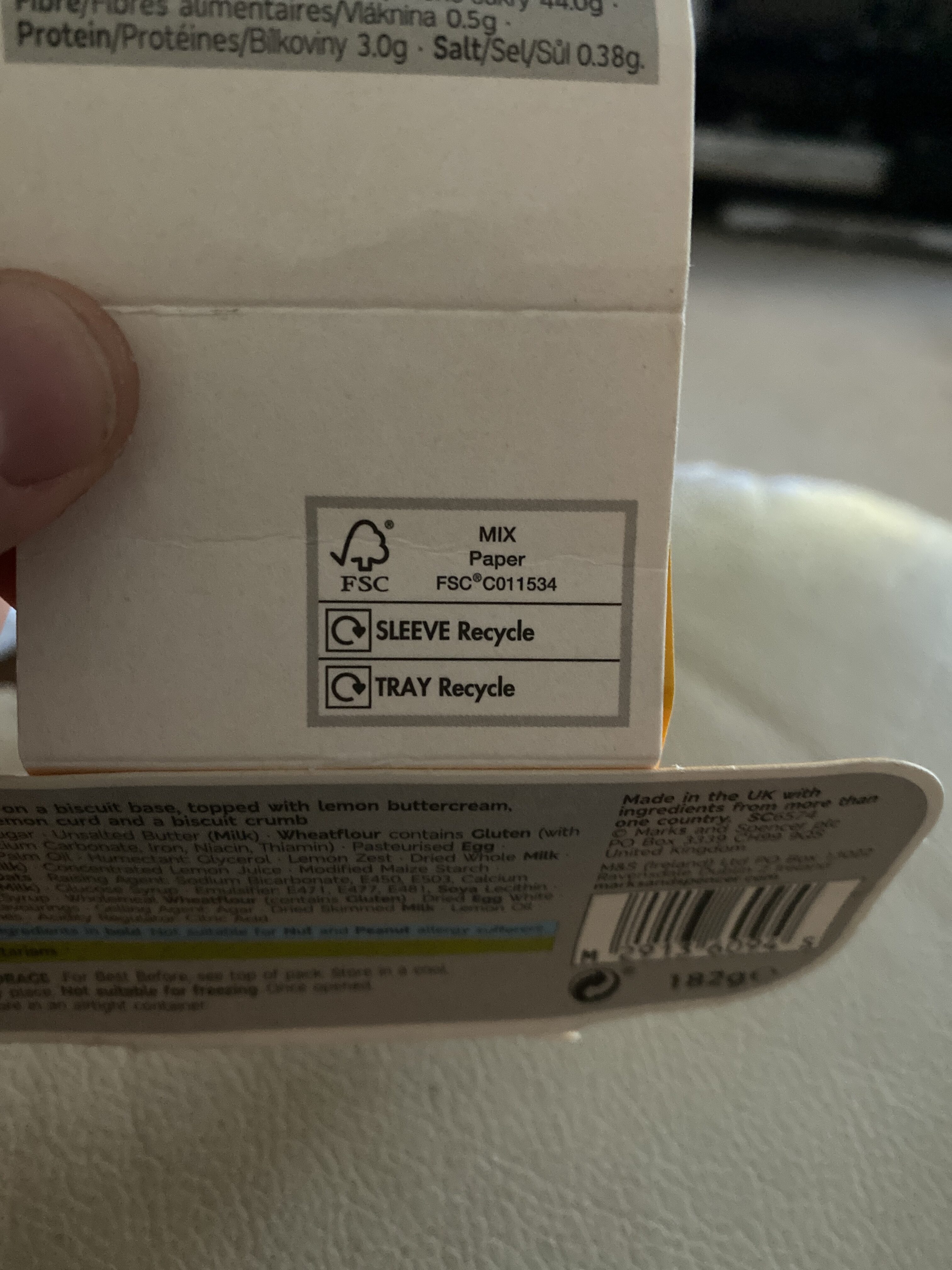Help us make food transparency the norm!
As a non-profit organization, we depend on your donations to continue informing consumers around the world about what they eat.
The food revolution starts with you!
Lemon meringue-a-tang - M&S Food - 91g
Lemon meringue-a-tang - M&S Food - 91g
Ambiguous barcode: This product has a Restricted Circulation Number barcode for products within a company. This means that different producers and stores can use the same barcode for different products.
×
Barcode: 29136094
Quantity: 91g
Packaging: Plastic tray
Brands: M&S Food
Categories: Snacks, Sweet snacks, Biscuits and cakes, Cakes
Labels, certifications, awards: N/a
Origin of ingredients: United Kingdom
Traceability code: FSC-C011534
Stores: Marks & Spencer
Countries where sold: United Kingdom
Matching with your preferences
Health
Ingredients
-
37 ingredients
Sugar Unsalted Butter (Milk) - Wheatflour contains Gluten (with Wheatflour, Calcium Carbonate, Iron, Niacin, Thiamin) - Pasteurised Egg Rapeseed Oil Palm Oil - Humectant Glycerol Lemon Zest Dried Whole Milk - Dried Whey (Milk)- Concentrated Lemon Juice Modified Maize Starch Palm Kernel Oil-Rolled Oats Raising Agent: Sodium Bicarbonate, E450, E503, Calcium Phosphates-Butter Oil (Milk) Glucose Syrup Emulsifier. E471, E477, E481, Soya Lecithin - Partially Inverted Sugar Syrup-Wholemeal Wheatflour (contains Gluten) Dried Egg White - Salt-Wheat Gluten - Flavourings - Gelling Agent Agar - Dried Skimmed Milk Lemon Oil nut Colour. Lutein, Carotenes Acidity Regulator. Citric Acid. For allergens see ingredients in bold. Not suitable for Nut and Peanut allergy sufferers. Suitable for vegetarians STORAGE For Best Before, see top of pack. Store in a cool dry place. Not suitable for freezing. Once opened, store in an airtight container. for lergAllergens: Gluten, Milk, Soybeans
Food processing
-
Ultra processed foods
Elements that indicate the product is in the 4 - Ultra processed food and drink products group:
- Additive: E161b - Lutein
- Additive: E322 - Lecithins
- Additive: E406 - Agar
- Additive: E450 - Diphosphates
- Additive: E471 - Mono- and diglycerides of fatty acids
- Additive: E477 - Propane-1‚2-diol esters of fatty acids
- Additive: E481 - Sodium stearoyl-2-lactylate
- Ingredient: Flavouring
- Ingredient: Gelling agent
- Ingredient: Whey
Food products are classified into 4 groups according to their degree of processing:
- Unprocessed or minimally processed foods
- Processed culinary ingredients
- Processed foods
- Ultra processed foods
The determination of the group is based on the category of the product and on the ingredients it contains.
Additives
-
E322 - Lecithins
Lecithins are natural compounds commonly used in the food industry as emulsifiers and stabilizers.
Extracted from sources like soybeans and eggs, lecithins consist of phospholipids that enhance the mixing of oil and water, ensuring smooth textures in various products like chocolates, dressings, and baked goods.
They do not present any known health risks.
-
E322i - Lecithin
Lecithins are natural compounds commonly used in the food industry as emulsifiers and stabilizers.
Extracted from sources like soybeans and eggs, lecithins consist of phospholipids that enhance the mixing of oil and water, ensuring smooth textures in various products like chocolates, dressings, and baked goods.
They do not present any known health risks.
-
E330 - Citric acid
Citric acid is a natural organic acid found in citrus fruits such as lemons, oranges, and limes.
It is widely used in the food industry as a flavor enhancer, acidulant, and preservative due to its tart and refreshing taste.
Citric acid is safe for consumption when used in moderation and is considered a generally recognized as safe (GRAS) food additive by regulatory agencies worldwide.
-
E406 - Agar
Agar: Agar -pronounced , sometimes - or agar-agar is a jelly-like substance, obtained from red algae.Agar is a mixture of two components: the linear polysaccharide agarose, and a heterogeneous mixture of smaller molecules called agaropectin. It forms the supporting structure in the cell walls of certain species of algae, and is released on boiling. These algae are known as agarophytes, and belong to the Rhodophyta -red algae- phylum.Agar has been used as an ingredient in desserts throughout Asia, and also as a solid substrate to contain culture media for microbiological work. Agar can be used as a laxative, an appetite suppressant, a vegetarian substitute for gelatin, a thickener for soups, in fruit preserves, ice cream, and other desserts, as a clarifying agent in brewing, and for sizing paper and fabrics.The gelling agent in agar is an unbranched polysaccharide obtained from the cell walls of some species of red algae, primarily from tengusa -Gelidiaceae- and ogonori -Gracilaria-. For commercial purposes, it is derived primarily from ogonori. In chemical terms, agar is a polymer made up of subunits of the sugar galactose.Source: Wikipedia
-
E450 - Diphosphates
Diphosphates (E450) are food additives often utilized to modify the texture of products, acting as leavening agents in baking and preventing the coagulation of canned food.
These salts can stabilize whipped cream and are also found in powdered products to maintain their flow properties. They are commonly present in baked goods, processed meats, and soft drinks.
Derived from phosphoric acid, they're part of our daily phosphate intake, which often surpasses recommended levels due to the prevalence of phosphates in processed foods and drinks.
Excessive phosphate consumption is linked to health issues, such as impaired kidney function and weakened bone health. Though diphosphates are generally regarded as safe when consumed within established acceptable daily intakes, it's imperative to monitor overall phosphate consumption to maintain optimal health.
-
E471 - Mono- and diglycerides of fatty acids
Mono- and diglycerides of fatty acids (E471), are food additives commonly used as emulsifiers in various processed foods.
These compounds consist of glycerol molecules linked to one or two fatty acid chains, which help stabilize and blend water and oil-based ingredients. E471 enhances the texture and shelf life of products like margarine, baked goods, and ice cream, ensuring a smooth and consistent texture.
It is generally considered safe for consumption within established regulatory limits.
-
E481 - Sodium stearoyl-2-lactylate
Sodium stearoyl lactylate: Sodium stearoyl-2-lactylate -sodium stearoyl lactylate or SSL- is a versatile, FDA approved food additive used to improve the mix tolerance and volume of processed foods. It is one type of a commercially available lactylate. SSL is non-toxic, biodegradable, and typically manufactured using biorenewable feedstocks. Because SSL is a safe and highly effective food additive, it is used in a wide variety of products ranging from baked goods and desserts to pet foods.As described by the Food Chemicals Codex 7th edition, SSL is a cream-colored powder or brittle solid. SSL is currently manufactured by the esterification of stearic acid with lactic acid and partially neutralized with either food-grade soda ash -sodium carbonate- or caustic soda -concentrated sodium hydroxide-. Commercial grade SSL is a mixture of sodium salts of stearoyl lactylic acids and minor proportions of other sodium salts of related acids. The HLB for SSL is 10-12. SSL is slightly hygroscopic, soluble in ethanol and in hot oil or fat, and dispersible in warm water. These properties are the reason that SSL is an excellent emulsifier for fat-in-water emulsions and can also function as a humectant.Source: Wikipedia
-
E500 - Sodium carbonates
Sodium carbonates (E500) are compounds commonly used in food preparation as leavening agents, helping baked goods rise by releasing carbon dioxide when they interact with acids.
Often found in baking soda, they regulate the pH of food, preventing it from becoming too acidic or too alkaline. In the culinary world, sodium carbonates can also enhance the texture and structure of foods, such as noodles, by modifying the gluten network.
Generally recognized as safe, sodium carbonates are non-toxic when consumed in typical amounts found in food.
-
E500ii - Sodium hydrogen carbonate
Sodium hydrogen carbonate, also known as E500ii, is a food additive commonly used as a leavening agent.
When added to recipes, it releases carbon dioxide gas upon exposure to heat or acids, causing dough to rise and resulting in a light, fluffy texture in baked goods.
It is generally recognized as safe (GRAS) by regulatory authorities when used in appropriate quantities and poses no significant health risks when consumed in typical food applications.
-
E503 - Ammonium carbonates
Ammonium carbonate: Ammonium carbonate is a salt with the chemical formula -NH4-2CO3. Since it readily degrades to gaseous ammonia and carbon dioxide upon heating, it is used as a leavening agent and also as smelling salt. It is also known as baker's ammonia and was a predecessor to the more modern leavening agents baking soda and baking powder. It is a component of what was formerly known as sal volatile and salt of hartshorn.Source: Wikipedia
Ingredients analysis
-
May contain palm oil
Ingredients that may contain palm oil: E471, E481
-
Non-vegan
Non-vegan ingredients: Whey, Egg whiteSome ingredients could not be recognized.
We need your help!
You can help us recognize more ingredients and better analyze the list of ingredients for this product and others:
- Edit this product page to correct spelling mistakes in the ingredients list, and/or to remove ingredients in other languages and sentences that are not related to the ingredients.
- Add new entries, synonyms or translations to our multilingual lists of ingredients, ingredient processing methods, and labels.
If you would like to help, join the #ingredients channel on our Slack discussion space and/or learn about ingredients analysis on our wiki. Thank you!
-
Vegetarian status unknown
Unrecognized ingredients: Sugar-unsalted-butter, Iron, Thiamin, Pasteurised-egg-rapeseed-oil-palm-oil, Humectant-glycerol-lemon-zest-dried-whole-milk, Concentrated-lemon-juice-modified-maize-starch-palm-kernel-oil-rolled-oats-raising-agent, Calcium-phosphates-butter-oil, Glucose-syrup-emulsifier, Partially-inverted-sugar-syrup-wholemeal-wheatflour, Salt-wheat-gluten, Dried-skimmed-milk-lemon-oil-nut-colour, Carotenes-acidity-regulator, Not-suitable-for-nut-and-peanut-allergy-sufferers, See-top-of-pack, Store-in-a-cool-dry-place, Not-suitable-for-freezing, Once-opened, Store-in-an-airtight-container, For-lergSome ingredients could not be recognized.
We need your help!
You can help us recognize more ingredients and better analyze the list of ingredients for this product and others:
- Edit this product page to correct spelling mistakes in the ingredients list, and/or to remove ingredients in other languages and sentences that are not related to the ingredients.
- Add new entries, synonyms or translations to our multilingual lists of ingredients, ingredient processing methods, and labels.
If you would like to help, join the #ingredients channel on our Slack discussion space and/or learn about ingredients analysis on our wiki. Thank you!
-
Details of the analysis of the ingredients
We need your help!
Some ingredients could not be recognized.
We need your help!
You can help us recognize more ingredients and better analyze the list of ingredients for this product and others:
- Edit this product page to correct spelling mistakes in the ingredients list, and/or to remove ingredients in other languages and sentences that are not related to the ingredients.
- Add new entries, synonyms or translations to our multilingual lists of ingredients, ingredient processing methods, and labels.
If you would like to help, join the #ingredients channel on our Slack discussion space and/or learn about ingredients analysis on our wiki. Thank you!
: Sugar Unsalted Butter (with Wheatflour, Calcium Carbonate, Iron, Niacin, Thiamin), Pasteurised Egg Rapeseed Oil Palm Oil, Humectant Glycerol Lemon Zest Dried Whole Milk, Whey, Concentrated Lemon Juice Modified Maize Starch Palm Kernel Oil-Rolled Oats Raising Agent (Sodium Bicarbonate), e450, e503, Calcium Phosphates-Butter Oil, Glucose Syrup Emulsifier, e471, e477, e481, Soya Lecithin, Partially Inverted Sugar Syrup-Wholemeal Wheatflour, Egg White, Salt-Wheat Gluten, Flavourings, Gelling Agent (Agar), Dried Skimmed Milk Lemon Oil nut Colour, Lutein, Carotenes Acidity Regulator, Citric Acid, Not suitable for Nut and Peanut allergy sufferers, STORAGE For Best Before, see top of pack, Store in a cool dry place, Not suitable for freezing, Once opened, store in an airtight container, for lerg- Sugar Unsalted Butter -> en:sugar-unsalted-butter - percent_min: 3.33333333333333 - percent_max: 100
- with Wheatflour -> en:wheat-flour - vegan: yes - vegetarian: yes - ciqual_proxy_food_code: 9410 - percent_min: 0.666666666666667 - percent_max: 100
- Calcium Carbonate -> en:e170i - vegan: maybe - vegetarian: maybe - percent_min: 0 - percent_max: 50
- Iron -> en:iron - percent_min: 0 - percent_max: 33.3333333333333
- Niacin -> en:e375 - vegan: maybe - vegetarian: maybe - percent_min: 0 - percent_max: 25
- Thiamin -> en:thiamin - percent_min: 0 - percent_max: 20
- Pasteurised Egg Rapeseed Oil Palm Oil -> en:pasteurised-egg-rapeseed-oil-palm-oil - percent_min: 0 - percent_max: 50
- Humectant Glycerol Lemon Zest Dried Whole Milk -> en:humectant-glycerol-lemon-zest-dried-whole-milk - percent_min: 0 - percent_max: 33.3333333333333
- Whey -> en:whey - vegan: no - vegetarian: maybe - percent_min: 0 - percent_max: 25
- Concentrated Lemon Juice Modified Maize Starch Palm Kernel Oil-Rolled Oats Raising Agent -> en:concentrated-lemon-juice-modified-maize-starch-palm-kernel-oil-rolled-oats-raising-agent - percent_min: 0 - percent_max: 20
- Sodium Bicarbonate -> en:e500ii - vegan: yes - vegetarian: yes - percent_min: 0 - percent_max: 20
- e450 -> en:e450 - vegan: yes - vegetarian: yes - percent_min: 0 - percent_max: 16.6666666666667
- e503 -> en:e503 - vegan: yes - vegetarian: yes - percent_min: 0 - percent_max: 14.2857142857143
- Calcium Phosphates-Butter Oil -> en:calcium-phosphates-butter-oil - percent_min: 0 - percent_max: 12.5
- Glucose Syrup Emulsifier -> en:glucose-syrup-emulsifier - percent_min: 0 - percent_max: 11.1111111111111
- e471 -> en:e471 - vegan: maybe - vegetarian: maybe - from_palm_oil: maybe - percent_min: 0 - percent_max: 10
- e477 -> en:e477 - vegan: maybe - vegetarian: maybe - percent_min: 0 - percent_max: 9.09090909090909
- e481 -> en:e481 - vegan: maybe - vegetarian: maybe - from_palm_oil: maybe - percent_min: 0 - percent_max: 8.33333333333333
- Soya Lecithin -> en:soya-lecithin - vegan: yes - vegetarian: yes - ciqual_food_code: 42200 - percent_min: 0 - percent_max: 7.69230769230769
- Partially Inverted Sugar Syrup-Wholemeal Wheatflour -> en:partially-inverted-sugar-syrup-wholemeal-wheatflour - percent_min: 0 - percent_max: 7.14285714285714
- Egg White -> en:egg-white - vegan: no - vegetarian: yes - ciqual_food_code: 22001 - percent_min: 0 - percent_max: 6.66666666666667
- Salt-Wheat Gluten -> en:salt-wheat-gluten - percent_min: 0 - percent_max: 6.25
- Flavourings -> en:flavouring - vegan: maybe - vegetarian: maybe - percent_min: 0 - percent_max: 5
- Gelling Agent -> en:gelling-agent - percent_min: 0 - percent_max: 5
- Agar -> en:e406 - vegan: yes - vegetarian: yes - ciqual_food_code: 11084 - percent_min: 0 - percent_max: 5
- Dried Skimmed Milk Lemon Oil nut Colour -> en:dried-skimmed-milk-lemon-oil-nut-colour - percent_min: 0 - percent_max: 5
- Lutein -> en:e161b - vegan: yes - vegetarian: yes - percent_min: 0 - percent_max: 5
- Carotenes Acidity Regulator -> en:carotenes-acidity-regulator - percent_min: 0 - percent_max: 4.76190476190476
- Citric Acid -> en:e330 - vegan: yes - vegetarian: yes - percent_min: 0 - percent_max: 4.54545454545455
- Not suitable for Nut and Peanut allergy sufferers -> en:not-suitable-for-nut-and-peanut-allergy-sufferers - percent_min: 0 - percent_max: 4.34782608695652
- STORAGE For Best Before -> en:storage-for-best-before - labels: en:vegetarian - vegetarian: en:yes - percent_min: 0 - percent_max: 4.16666666666667
- see top of pack -> en:see-top-of-pack - percent_min: 0 - percent_max: 4
- Store in a cool dry place -> en:store-in-a-cool-dry-place - percent_min: 0 - percent_max: 3.84615384615385
- Not suitable for freezing -> en:not-suitable-for-freezing - percent_min: 0 - percent_max: 3.7037037037037
- Once opened -> en:once-opened - percent_min: 0 - percent_max: 3.57142857142857
- store in an airtight container -> en:store-in-an-airtight-container - percent_min: 0 - percent_max: 3.44827586206897
- for lerg -> en:for-lerg - percent_min: 0 - percent_max: 3.33333333333333
Nutrition
-
Bad nutritional quality
⚠ ️Warning: the amount of fruits, vegetables and nuts is not specified on the label, it was estimated from the list of ingredients: 0This product is not considered a beverage for the calculation of the Nutri-Score.
Positive points: 0
- Proteins: 1 / 5 (value: 3, rounded value: 3)
- Fiber: 0 / 5 (value: 0.5, rounded value: 0.5)
- Fruits, vegetables, nuts, and colza/walnut/olive oils: 0 / 5 (value: 0, rounded value: 0)
Negative points: 23
- Energy: 5 / 10 (value: 1847, rounded value: 1847)
- Sugars: 9 / 10 (value: 44, rounded value: 44)
- Saturated fat: 8 / 10 (value: 8.1, rounded value: 8.1)
- Sodium: 1 / 10 (value: 152, rounded value: 152)
The points for proteins are not counted because the negative points are greater or equal to 11.
Nutritional score: (23 - 0)
Nutri-Score:
-
Nutrient levels
-
Fat in high quantity (20.5%)
What you need to know- A high consumption of fat, especially saturated fats, can raise cholesterol, which increases the risk of heart diseases.
Recommendation: Limit the consumption of fat and saturated fat- Choose products with lower fat and saturated fat content.
-
Saturated fat in high quantity (8.1%)
What you need to know- A high consumption of fat, especially saturated fats, can raise cholesterol, which increases the risk of heart diseases.
Recommendation: Limit the consumption of fat and saturated fat- Choose products with lower fat and saturated fat content.
-
Sugars in high quantity (44%)
What you need to know- A high consumption of sugar can cause weight gain and tooth decay. It also augments the risk of type 2 diabetes and cardio-vascular diseases.
Recommendation: Limit the consumption of sugar and sugary drinks- Sugary drinks (such as sodas, fruit beverages, and fruit juices and nectars) should be limited as much as possible (no more than 1 glass a day).
- Choose products with lower sugar content and reduce the consumption of products with added sugars.
-
Salt in moderate quantity (0.38%)
What you need to know- A high consumption of salt (or sodium) can cause raised blood pressure, which can increase the risk of heart disease and stroke.
- Many people who have high blood pressure do not know it, as there are often no symptoms.
- Most people consume too much salt (on average 9 to 12 grams per day), around twice the recommended maximum level of intake.
Recommendation: Limit the consumption of salt and salted food- Reduce the quantity of salt used when cooking, and don't salt again at the table.
- Limit the consumption of salty snacks and choose products with lower salt content.
-
-
Nutrition facts
Nutrition facts As sold
for 100 g / 100 mlAs sold
per serving (100g)Compared to: Cakes Energy 1,847 kj
(441 kcal)1,850 kj
(441 kcal)+13% Fat 20.5 g 20.5 g +16% Saturated fat 8.1 g 8.1 g +21% Carbohydrates 60.8 g 60.8 g +16% Sugars 44 g 44 g +50% Fiber 0.5 g 0.5 g -72% Proteins 3 g 3 g -41% Salt 0.38 g 0.38 g -45% Fruits‚ vegetables‚ nuts and rapeseed‚ walnut and olive oils (estimate from ingredients list analysis) 0 % 0 %
Environment
-
Eco-Score not computed - Unknown environmental impact
We could not compute the Eco-Score of this product as it is missing some data, could you help complete it?Could you add a precise product category so that we can compute the Eco-Score? Add a category
Packaging
-
Packaging with a medium impact
-
Packaging parts
Tray (Plastic)
-
Packaging materials
Material % Packaging weight Packaging weight per 100 g of product Plastic
-
Transportation
-
Origins of ingredients
Origins of ingredients with a medium impact
Origin of the product and/or its ingredients % of ingredients Impact United Kingdom 100 %Medium
Report a problem
-
Incomplete or incorrect information?
Category, labels, ingredients, allergens, nutritional information, photos etc.
If the information does not match the information on the packaging, please complete or correct it. Open Food Facts is a collaborative database, and every contribution is useful for all.
Data sources
Product added on by openfoodfacts-contributors
Last edit of product page on by packbot.
Product page also edited by roboto-app, teolemon.












